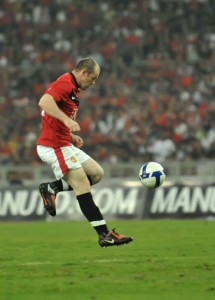
In the last four years an extensive research project has studied the physical demands of soccer (football) and effects on physical fitness in children, adolescents, adults, men and women and old men.
Results
The results show that regular participation in soccer effectively stimulates muscle-skeletal fitness, cardio-vascular fitness and metabolic fitness. It has been observed that 3-4 months with 2-3 weekly training sessions causes significant improvements in maximal oxygen uptake, intermittent exercise performance and sprinting speed for untrained men (Krustrup et al. 2009a + b, Pedersen et al. 2009) and women (Bangsbo et al . 2010). Studies examining the long-term effects (15-16 months) of soccer for men and women have furthermore concluded that recreational soccer training improves jump height and muscle strength (Randers et al. 2010b; Krustrup et al. 2010c).
The observed performance effects are related to an increase in muscle mass, oxidative enzyme activity and improved systolic and diastolic heart function as well as an improved fat oxidation during low-intensity exercise after only 3-4 months of training for men and women (Krustrup et al. 2009a + b; Andersen et al. 2010; Bangsbo et al. 2010).
As an example, maximal oxygen uptake increased by 13% and 15% for men and women after 3-4 months of training. At the muscular level, the number of capillaries per fiber increased, respectively 22 and 23%, while citrate syntheses enzyme activity increased by 14% and 12% (Krustrup a al., 2009a+b; Bangsbo et al. 2010). For a group of men, the training frequency was reduced from 2.4 times at 1 hour a week in the first 12 weeks to 1.3 times at 1 hour weekly for the subsequent 52 weeks. Despite the reduced training frequency it was possible to maintain beneficial effects on endurance, maximal oxygen uptake, intermittent work capacity and balance, while sprinting speed (1.5-3.0%), jump height (4%) and muscle glycogen levels (19-21%) had increased and blood lactate during sub-maximal exercise was markedly reduced (27-72%; Randers et al. 2010b).
Investigations of the activity patterns during soccer training for untrained men and women show 850-1400 changes of activity per hour including approximately 100 intense running bouts (Randers et al., 2010a), which emphasize the intermittent nature of soccer. Moreover, 150-200 intense action are performed, such as tackles, shots, turns, accelerations and stops (Randers et al. 2010a, Pedersen et al., 2009). The average heart rate was observed to be 81-84% of maximal heart rate of untrained men and women, with periods of near-maximal values and 11-22% of the total time with heart rates above 90% of maximum heart rate (Randers et al., 2010a).
This heart rate response was found regardless of the number of players, including small-sided games with 2, 4, 6, 8 and 14 players (Randers et al. 2010a). Likewise, high heart rates and multiple intense actions have been observed for kids, adult men, elderly men and women (Randers et al. 2010a). Together these data show that it is easy to achieve a combination of cardio-vascular- and strength training for a range of people, including untrained and inexperienced children, adolescents, adults, men and women, social vulnerable and elderly men.








